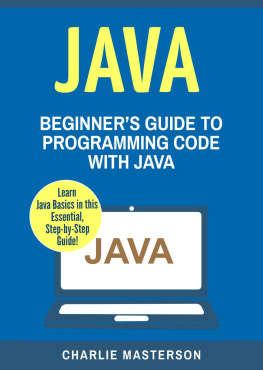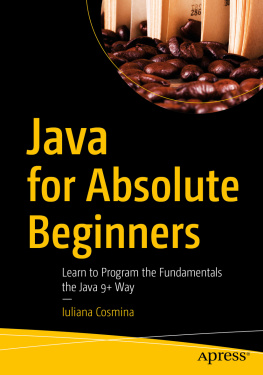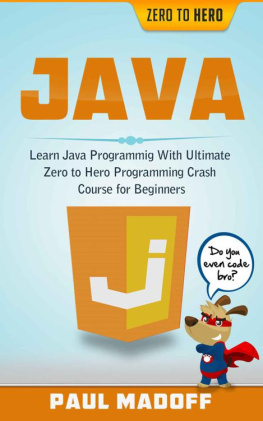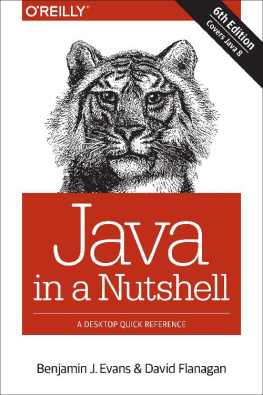L. - Java For Beginners. Learn Java Fast
Here you can read online L. - Java For Beginners. Learn Java Fast full text of the book (entire story) in english for free. Download pdf and epub, get meaning, cover and reviews about this ebook. year: 2017, publisher: UNKNOWN, genre: Home and family. Description of the work, (preface) as well as reviews are available. Best literature library LitArk.com created for fans of good reading and offers a wide selection of genres:
Romance novel
Science fiction
Adventure
Detective
Science
History
Home and family
Prose
Art
Politics
Computer
Non-fiction
Religion
Business
Children
Humor
Choose a favorite category and find really read worthwhile books. Enjoy immersion in the world of imagination, feel the emotions of the characters or learn something new for yourself, make an fascinating discovery.

- Book:Java For Beginners. Learn Java Fast
- Author:
- Publisher:UNKNOWN
- Genre:
- Year:2017
- Rating:5 / 5
- Favourites:Add to favourites
- Your mark:
- 100
- 1
- 2
- 3
- 4
- 5
Java For Beginners. Learn Java Fast: summary, description and annotation
We offer to read an annotation, description, summary or preface (depends on what the author of the book "Java For Beginners. Learn Java Fast" wrote himself). If you haven't found the necessary information about the book — write in the comments, we will try to find it.
L.: author's other books
Who wrote Java For Beginners. Learn Java Fast? Find out the surname, the name of the author of the book and a list of all author's works by series.
Java For Beginners. Learn Java Fast — read online for free the complete book (whole text) full work
Below is the text of the book, divided by pages. System saving the place of the last page read, allows you to conveniently read the book "Java For Beginners. Learn Java Fast" online for free, without having to search again every time where you left off. Put a bookmark, and you can go to the page where you finished reading at any time.
Font size:
Interval:
Bookmark:
Java For Beginners Learn Java Fast (Free Bonus Video Course Included)
Thanks again for downloading this book, I hope you enjoy it! Copyright 2017 George L - All rights reserved. This document is geared towards providing exact and reliable information in regards to the topic and issue covered. The publication is sold with the idea that the publisher is not required to render accounting, officially permitted, or otherwise, qualified services. If advice is necessary, legal or professional, a practiced individual in the profession should be ordered. - From a Declaration of Principles which was accepted and approved equally by a Committee of the American Bar Association and a Committee of Publishers and Associations. In no way is it legal to reproduce, duplicate, or transmit any part of this document in either electronic means or in printed format.
Recording of this publication is strictly prohibited and any storage of this document is not allowed unless with written permission from the publisher. All rights reserved. The information provided herein is stated to be truthful and consistent, in that any liability, in terms of inattention or otherwise, by any usage or abuse of any policies, processes, or directions contained within is the solitary and utter responsibility of the recipient reader. Under no circumstances will any legal responsibility or blame be held against the publisher for any reparation, damages, or monetary loss due to the information herein, either directly or indirectly. Respective authors own all copyrights not held by the publisher. The information herein is offered for informational purposes solely, and is universal as so.
The presentation of the information is without contract or any type of guarantee assurance. The trademarks that are used are without any consent, and the publication of the trademark is without permission or backing by the trademark owner. All trademarks and brands within this book are for clarifying purposes only and are the owned by the owners themselves, not affiliated with this document.
Do be careful of excessive use, though, because it can make the code hard to read.
Generally, we format a Java file so that it becomes easier to read. To format a Java file, we need to look at style guidelines. Style guidelines are mainly standards followed by company, organization or individual. Generally, when setting guidelines developers keep in mind formatting of code which is easier to read. This formatting is ignored by the compiler. Styles include the use of indentation, spacing, and newlines which format source codes as per developers.
Comments are used to format code and add notes so that any other programmer reading the code gets the idea behind the code.
Example 1 Bad Formatting // Bad Style Coding // Not easy to read, no indents usedpublic class Welcome {public static void main(String[] args){int i = 0; // single line commentfor(int i=0;i<=10;i++){int j = 1;int k = j;System.out.println("Welcome to comments");}} Example 2 Good Formatting // Good Style Coding // Very easy to read, excellent use of indentspublic class Welcome {public static void main(String[] args){int i = 0; // single line commentfor(int i=0;i<=10;i++){int j = 1;int k = j;System.out.println("Welcome to comments");}}}
Font size:
Interval:
Bookmark:
Similar books «Java For Beginners. Learn Java Fast»
Look at similar books to Java For Beginners. Learn Java Fast. We have selected literature similar in name and meaning in the hope of providing readers with more options to find new, interesting, not yet read works.
Discussion, reviews of the book Java For Beginners. Learn Java Fast and just readers' own opinions. Leave your comments, write what you think about the work, its meaning or the main characters. Specify what exactly you liked and what you didn't like, and why you think so.






